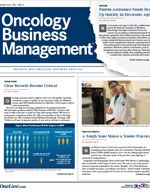Brace for a Dark and Stormy 2017
Although many reform efforts are based on good intentions, these efforts are not always well respected. There is a drive afoot to terminate the charter for the Center for Medicare & Medicaid Innovation.
OncLive Chairman,
Mike Hennessy
Although many reform efforts are based on good intentions, these efforts are not always well respected. There is a drive afoot to terminate the charter for the Center for Medicare & Medicaid Innovation (CMMI). The much-maligned Medicare Part B experiment for adjusting physician pay is one such innovation to have come from this agency. But CMMI is projected to save $34 billion through 2026, and congressional leaders now say it’s so hard to find savings like that elsewhere in the federal budget that they would feel severely conflicted about pulling the plug on CMMI. Go figure!
When it rains, it pours, and with the payer industry now getting cold feet about participating in health care exchanges, there’s a rush for the exit doors. In just the past year, Aetna, Humana, and UnitedHealthcare have each announced plans to withdraw from these markets. Also reducing market exposure is Blue Cross Blue Shield. With such an exodus, one can’t help wondering about the hardship toll for patients and the confusion in independent oncology clinics that must suddenly nd new ways to connect patients in need with funds for care.
Patients in the southeastern United States are forecast to take the brunt of these changes when the latest pullouts take effect in January: in the path of the storm are Arizona, North and South Carolina, Georgia, parts of Florida, and various rural areas. For our front page story on this, we obtained various perspectives, including an interview with an Arizona oncologist who peeled back the curtains on how this driest of states is about to become drier in terms of affordable coverage. Our story goes into detail about this erosion in private payer support for the Affordable Care Act.
Also this month, we write about oncologists’ strong suspicion of CVS Health’s recent decision to exclude nonlicensed pharmacy operations from the Medicare Part D drug program, which covers the increasingly lucrative class of oral oncolytics. CVS has grown into such a giant in the industry—both as a pharmacy bene t manager and as the owner
of nearly 10,000 licensed pharmacies—that the effect on in-house pharmacy at oncology practices is going to be nothing short of seismic. CMS policy supports this action by CVS, but oncology representatives we spoke with for this story told us the policy doesn’t make sense. It is liable to make patient care less efficient and lead to worse outcomes, they said. You’ll want to read this story.
There’s much more news and information packed into Oncology Business ManagementTM this month. We talked to Edward Ambinder, MD, of Mount Sinai Hospital in New York, who speaks with great optimism about the progress being made toward medical device and computer interoperability. And, in our practice profile, we look at oncologists in California who divided their cancer patients into nine cohorts and assigned a at bundle fee for each type. It seems too simple to succeed, and yet it did. Read all about it, and more, in this month’s issue!




